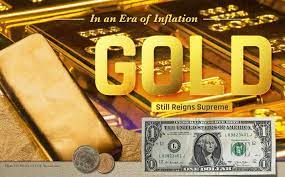Gold As Inflation Hedge
Gold’s Historical Track Record as an Inflation Hedge
People have owned gold as a store of value for thousands of years. It also has real-world uses in jewelry and electronics, which provides even more tangible value. And unlike fiat currencies, there is a relatively limited supply of gold.


Is Gold An Inflation Hedge?
 Getty
GettyPeople have owned gold as a store of value for thousands of years. It also has real-world uses in jewelry and electronics, which provides even more tangible value. And unlike fiat currencies, there is a relatively limited supply of gold.
For these reasons, gold has long been considered a safe-haven investment and a hedge against inflation. Trouble is, gold has a mixed record when it comes to whether it can actually provide a good hedge against inflation.
Gold’s Historical Track Record as an Inflation Hedge
In mid-2022, measures of U.S. inflation were hitting multi-decade highs. The last time the U.S. experienced out-of-control inflation was the 1970s and early 1980s. Looking back at this period provides insight into why investors think of gold as a hedge against inflation.
Oil price shocks and energy shortages drove average annual inflation in the U.S. to around 8.8% from 1973 to 1979. During those six years, gold won over many investors as a top inflation hedge since the yellow metal generated an impressive 35% annualized return.
Gold’s performance since that time has been lackluster. From 1980 to 1984, annual inflation averaged 6.5%, but gold prices fell 10% on average each year. Returns not only fell short of the inflation rate, but they also underperformed real estate, commodities and the S&P 500.
Annual inflation averaged about 4.6% from 1988 to 1991, but gold prices fell approximately 7.6% a year on average.
“A hedge against inflation would typically increase in value in line with the sharp rise in consumer prices,” says Jason Porter, senior investment manager at Scottish Heritage SG. “However, during some of the most recent, extreme moments of inflation in the U.S., gold has produced a negative return for investors.”
Gold’s Performance as an Inflation Hedge Today
The consumer price index (CPI), a popular measure of U.S. inflation, gained 4.2% year over year in April 2021, its first annualized gain of more than 4% since 2008. Since then, average annual U.S. CPI growth has been around 6.8%. Gold prices have eked out an average annual growth rate of 1% over the same period.
Darren Colananni, wealth management advisor for Centurion Wealth Management, says that gold’s weak performance recently reveals its shortcomings as an inflation hedge.
“Gold prices have actually been trading sideways to down for almost two years while inflation is at multi-decade highs,” Colananni says.
Some studies have found that gold can be an effective inflation hedge, but only over an extremely long time horizon of more than a century.
Over shorter periods, researchers found gold’s inflation-adjusted price fluctuates dramatically. Since 1972, the ratio of gold’s price to the CPI has averaged 3.6. The current gold-to-CPI ratio is 6.5. If gold were a simple, reliable inflation hedge, its value would remain roughly constant relative to the CPI.
Gold vs. Bitcoin: Which Is Better for Inflation?
Gold may not have offered the best protection against inflation over the past two years, but it’s certainly outperformed another widely touted inflation hedge: Bitcoin.
Some cryptocurrency investors argue that crypto is the best inflation hedge because its supply is fixed. Central banks worldwide are free to increase the supply of money at will and miners can dig up more gold, but the total amount of Bitcoin and some other cryptocurrencies is strictly capped.
Enthusiasts often refer to Bitcoin as “digital gold.” In reality, Bitcoin’s recent performance as an inflation hedge has been abysmal. Since U.S. inflation began to heat up in 2021, the price of BTC has plummeted by 47% year over year.
Bitcoin and other leading cryptocurrencies have left gold in the dust over the longer term. BTC is up 479% over the past five years, compared to a mere 38% gain for gold.
Yet the past two years have presented the first test of Bitcoin as an inflation hedge during a period of sharply rising prices—and it’s proven to be anything but digital gold.
What Are the Best Inflation Hedges?
Neither gold nor so-called digital gold has helped investors effectively fend off the current bout of inflation. So what are the alternatives?
Asher Rogovy, chief investment officer at Magnifina, says the best long-term inflation hedge has historically been the stock market.
“I’m always surprised how often investors forget that plain old stocks hedge against inflation over the long term,” says Rogovy. “Of course, stock valuations may fluctuate with the day’s economic news, but across multiple business cycles, market indices have significantly outperformed inflation.”
The S&P 500 may be volatile and unpredictable over the short term. But the S&P 500’s returns have been remarkably consistent when measured in decades.
Since 1926, the rolling annual 30-year S&P 500 return has stayed between about 8% and 15%. Returns like these are more than enough to hedge against all but the most extreme periods of inflation.
For investors uncomfortable with stock market volatility, the U.S. Treasury has designed a type of bond specifically to combat inflation. Colananni recommends I bonds as the best potential inflation hedge.
“The interest rate adjusts every six months with inflation and you can purchase up to $10,000 per person per calendar year,” he says.
I bonds currently yield 9.62% and are guaranteed by the U.S. government. But investors must hold them for at least one year. you lose the last three months of interest if you cash out inside of five years.
Benefits of Investing in Gold
Gold has been an inconsistent inflation hedge, but there may still be benefits to holding a small amount of the yellow metal in your portfolio. Gold has historically had a low or even negative correlation to both stocks and bonds, suggesting it offers value as a tool of diversification.
Gold prices held up pretty well during the Covid-19 pandemic market sell-off in early 2020, for example. From Feb. 1 to April 1 in 2020, the S&P 500 declined 23% while the price of gold dropped less than 0.1%.
Demand for gold from investors, central banks, jewelers and tech companies is also growing. According to the World Gold Council, global gold demand increased 12% year over year to 2.189 tons in the first half of 2022.
Depending on your individual goals, there are several easy ways to invest in gold. Investors can buy gold bullion, physical bars or coins that can be kept in a safe or bank.
You can also buy physical gold exchange-traded funds (ETFs) that hold gold bullion on investors’ behalf. The most popular gold ETF is SPDR Gold Shares (GLD).
Investors looking to speculate in the gold market can trade gold futures contracts. These contracts provide significant leverage, allowing investors to control large quantities of gold with a relatively small amount of money.
Finally, investors can buy shares of individual gold stocks or a gold mining ETF. The VanEck Gold Miners ETF (GDX) holds a diversified basket of 54 gold-related stocks, including Newmont Corp. (NEM), Barrick Gold Corp. (GOLD) and Franco-Nevada Corp. (FNV).
Gold As Inflation Hedge
BROUGHT TO YOU BY:
![]()
https://preciousmetalsinvestmentguide.org



